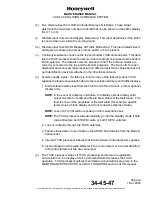
Page 53
1 Dec 2003
34-45-4
7
MAINTENANCE MANUAL
CAS-100 COLLISION AVOIDANCE SYSTEM
Use or disclosure of information on this page is subject to the restrictions in the proprietary notice of this document.
ATCRBS Mode A/C transponders in the adjacent airspace that sense a suppression
beam signal larger in amplitude than the main beam signal, are prevented from replying
to the interrogation. The result of the ATCRBS P2 hold back is to control the good TCAS
interrogation beam width and thus limit interference from unwanted ATCRBS receptions.
The effective beam width can be narrowed by increasing the amplitude of the
suppression P2 pattern output or decreasing the amplitude of the main beam pattern
output (and vice-versa).
During TCAS receptions, each of the four directional antenna elements receives any
1090 MHz signal that passes by the element. The phasing of these received signals is
determined by the direction that the rf energy is received. These signals are received on
the same four cables that connect transmit signals between the TCAS processor and
directional antenna.
Many filters are used in the TCAS processor for noise suppression and pulse shaping of
the received signals. Phase detectors in the TCAS processor then examine the relative
phasing of the four signals from the antenna and make an analog voltage that shows the
bearing of the replying intruder aircraft.
The main beam pointing angle can be redirected in microseconds to any of the four 90
pointing positions.
Four coaxial cables with type Threaded N Connector (TNC) plugs on the antenna end
connect the directional antenna to the TCAS processor.
Each of the four ports of the directional antenna contains a resistor found across the
antenna element to ground. Each of the four resistors is a different value. The TCAS
processor at intervals does a continuity check on the antenna ports and must see the
correct resistance value (through an A/D converter) if the port is not shorted or not open.
The directional antenna is a passive device and does not require aircraft power.






























